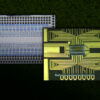A recent study by the Helmholtz Institute Erlangen-Nuremberg, which is based at Forschungszentrum Jülich, has developed an efficient and environmentally friendly process for recycling perovskite solar cells.
The paper, published in the journal Energy & Environmental Science, presents a method with which up to 99.97% of the materials used in a solar cell can be recovered and reused—with comparable efficiency, less waste and lower costs. This is the first time that such a high level of efficiency has been achieved in the recycling of perovskite solar cells.
Using layer-by-layer solvent extraction, the research team has succeeded in recovering the individual components, purifying them and producing new solar cells from them. The method could enable a closed recycling loop for solar modules for the first time, which conserves resources and reduces waste.
This approach represents an advantage of perovskite solar cells over conventional silicon solar cells. Separating the individual components of silicon photovoltaic modules is very laborious due to the integrated, i.e., hardly separable, structure of the modules, which nevertheless enables the modules to have a long service life.
“The most significant aspect of this paper is its comprehensive evaluation. It goes beyond merely developing a recycling approach by thoroughly accessing its efficacy, economic viability, and environmental impact,” says Zhenni Wu from the lead team of researchers involved from the Helmholtz Institute Erlangen-Nuremberg.
Photovoltaics (PV) plays a crucial role in the energy transition. The solar industry continues to grow: enormous capacities are set to be added in the coming decades. Although PV modules are designed to last as long as possible, up to now they have ended up in landfill along with their valuable materials at the end of their life. This means that not only material but also potential for savings is lost.
Technical and economic forecasts from the study indicate that the proposed recycling process has the potential for significant cost savings. In the laboratory, recycling could reduce material costs by up to 64%, and in industrial production by up to 61%.
More information:
Zhenni Wu et al, Closing the loop: recycling of MAPbI3 perovskite solar cells, Energy & Environmental Science (2024). DOI: 10.1039/D4EE01071J
Provided by
Forschungszentrum Juelich
Citation:
New recycling process can recover up to 99.97% of materials in perovskite solar cells (2024, July 2)



